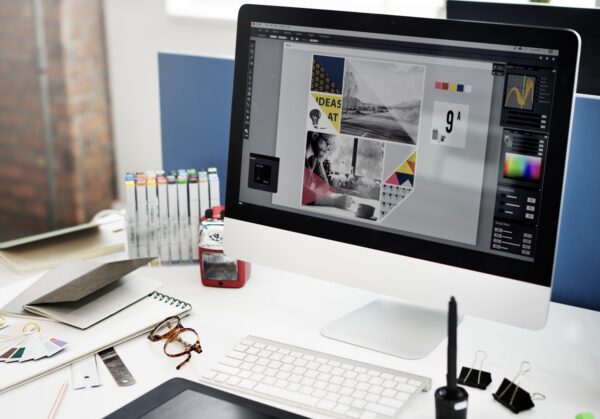Want to Be a Designer? Your Ultimate Guide to Choosing a Graphic Design Course
Ever stopped to truly look at the world around you? The elegant logo on your coffee cup, the intuitive app on your phone, the compelling poster for a concert, the clean layout of your favourite website—this is the silent, pervasive language of graphic design. It’s a discipline that lives in the intersection of art and purpose, where creativity meets strategy to solve problems and communicate ideas.
If you’ve ever felt the pull to not just consume this visual world but to shape it, you’ve likely considered a graphic design course. But where do you even begin? The options are vast, from intensive university degrees to nimble online bootcamps and everything in between. This guide will demystify the journey, helping you navigate the different types of courses, understand what you’ll truly learn, and choose the path that’s perfectly aligned with your goals.
Why Take a Graphic Design Course? Beyond “Making Things Look Pretty”
Before we dive into the “how,” let’s solidify the “why.” You might have a natural eye for colour or enjoy dabbling in digital art, but a structured course offers something far more powerful than just software skills.
- Foundation, Not Just Flair: Natural talent is a fantastic starting point, but design is built on fundamental principles. A good course will ingrain the core tenets of typography, colour theory, composition, hierarchy, balance, and contrast. These are the unshakeable rules you learn before you can effectively break them. It’s the difference between guessing what looks good and knowing why it works.
- Constructive Critique (And How to Take It): Design is not created in a vacuum. Learning to give and receive feedback is a critical professional skill. In a course environment, your work will be scrutinised by instructors and peers. This process, while sometimes daunting, thickens your skin and teaches you to divorce your ego from your work—a necessity for thriving in a client-based industry.
- Building a Killer Portfolio: A portfolio is your passport to a design career. It’s not enough to say you can design; you have to show it. Most quality courses are structured around creating a body of work—a series of projects that solve real-world briefs. This curated collection is infinitely more valuable than a certificate alone.
- Navigating the Professional World: A comprehensive course won’t just teach you how to use Illustrator; it will teach you how to be a designer. This includes understanding client relationships, crafting proposals, pricing your work, navigating copyright law, and building a personal brand.
The Landscape of Learning: Types of Graphic Design Courses
Your ideal course depends on your current life situation, learning style, budget, and career aspirations. Here’s a breakdown of the main avenues.
1. University Degree (BA/BFA)
This is the traditional, comprehensive path. Typically lasting 3-4 years, a design degree offers a deep, theoretical, and holistic education.
- Pros: Immersive experience, well-rounded education covering art history and theory, strong focus on critical thinking and conceptual development, excellent networking opportunities, and a degree that checks a box for some employers.
- Cons: Significant time and financial investment, can be heavy on theory versus practical, fast-paced software teaching, curriculum can sometimes lag behind industry trends.
- Ideal For: School leavers seeking a full-time, immersive experience, those who value a formal degree, and individuals wanting a deep, conceptual foundation in design.
2. Associate Degrees & Diplomas from Colleges
These are typically 1-2 year programmes offered by community colleges or specialised art schools. They are more focused on practical, vocational skills.
- Pros: More affordable and less time-consuming than a degree, highly practical and hands-on, and often strong connections to local industries for job placement.
- Cons: Less focus on deep theory and history, may not carry the same prestige as a university degree.
- Ideal For: Those looking for a faster, more affordable route to gain employable skills and enter the workforce quickly.
3. Online Certificates & Bootcamps (e.g., Coursera, LinkedIn Learning, Skillshare, Shillington)
This is the most explosive growth area in design education. These courses range from short, specific software tutorials to intensive, multi-month bootcamps that mimic a full-time course structure.
- Pros: Extreme flexibility to learn at your own pace, often very affordable (or even free for basic content), access to world-class instructors, a wide variety of niche topics, and can be done from anywhere.
- Cons: Requires immense self-discipline and motivation, lack of in-person camaraderie and immediate feedback, quality can vary wildly, and certificates may hold less weight than a diploma.
- Ideal For: Career-changers who need to keep their day job, self-starters, those looking to skill-up in a specific area, or anyone testing the waters before committing to a longer programme.
4. Workshops & Short Courses
Often hosted by design studios, industry organisations, or software companies (like Adobe), these are short, intensive sessions focused on a single skill—like lettering, UX prototyping, or motion graphics.
- Pros: Excellent for advanced learning or picking up a very specific new skill, great for networking with professionals, and a short time commitment.
- Cons: Not for building foundational knowledge, can be expensive for their length.
- Ideal For: Practicing designers looking to expand their skill set or stay on top of trends.
The Core Curriculum: What You’ll Learn
While every course is different, most reputable programmes will cover a similar core set of subjects. Expect to get your hands dirty with:
- Design Principles: The non-negotiable basics. You’ll live and breathe grids, learn how to create visual hierarchy to guide the viewer’s eye, and understand how to use contrast to create impact.
- Typography: Arguably the most important skill for any designer. You’ll learn the anatomy of type, how to pair fonts, and how to set type for both readability and dramatic effect.
- Colour Theory: Moving beyond “what looks nice,” you’ll learn about colour psychology, how to create palettes for different moods and audiences, and the technicalities of CMYK (for print) vs. RGB (for screen).
- Industry-Standard Software: You’ll become proficient in the Holy Trinity of design apps:
- Adobe Illustrator: For vector-based graphics (logos, icons, illustrations) that can be scaled infinitely without losing quality.
- Adobe Photoshop: For photo editing, manipulation, and digital painting (raster-based).
- Adobe InDesign: For multi-page layout design like magazines, brochures, and books.
- Branding & Identity Design: This is where it all comes together. You’ll learn how to build a visual identity from the ground up—crafting a logo, selecting a colour palette and typography, and defining how it all works across various touchpoints (business cards, websites, packaging).
- Portfolio Development: The capstone of your studies. You’ll work on real-world briefs, receive critiques, and refine your projects into a professional, presentation-ready portfolio.
Increasingly, modern courses are also integrating UI (User Interface) and UX (User Experience) principles, as the lines between graphic design and digital product design continue to blur.
How to Choose the Right Course for You: A Checklist
With so many options, making a decision can feel overwhelming. Ask yourself these questions:
- What are my career goals? Do you want to work at a major agency, freelance, or design in-house for a specific company? Research job listings for your dream role—what qualifications do they ask for?
- What is my learning style? Do you thrive in a structured classroom with deadlines and direct instructor access? Or are you a disciplined self-learner who prefers to go at your own pace?
- What is my budget? Be realistic. Factor in not just tuition, but also software subscriptions (Adobe Creative Cloud is a monthly cost), hardware (a reliable computer is essential), and materials.
- Who is the instructor? Especially for online courses, research the instructor. Are they a working professional with a portfolio you admire? Practical experience is often more valuable than pure academic credentials.
- What does the portfolio of past graduates look like? This is the single best indicator of a course’s quality. If the students’ final work looks professional and impressive, the course is doing something right. If it looks amateurish, steer clear.
Life After the Course: You’ve Graduated, Now What?
Completing a course is just the beginning. The field of design is one of constant evolution.
Embrace the Grind: Your first job might not be your dream job, and that’s okay. Whether it’s an internship, a junior role, or your first nervous freelance client, every project is a chance to learn, grow, and add another strong piece to your portfolio.
Your Portfolio is Your Everything: Never stop refining it. Treat it as a living document. As you complete better work, replace older, weaker pieces.
Never Stop Learning: Trends, tools, and technologies change. Subscribe to design blogs (It’s Nice That, Design Week), follow inspiring designers on Instagram and Behance, and always be curious.
Find Your Community: Join online forums (like the Designers Guild on Facebook), attend local meetups, and connect with other designers. This network will be your source of support, inspiration, and job opportunities.



